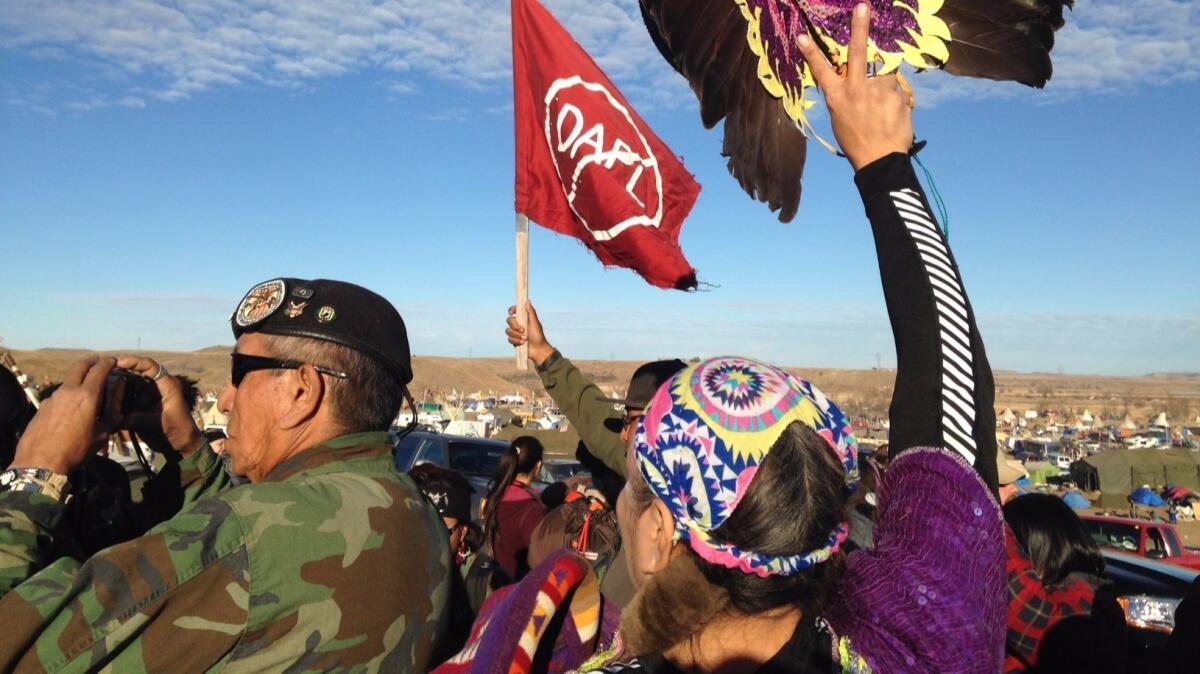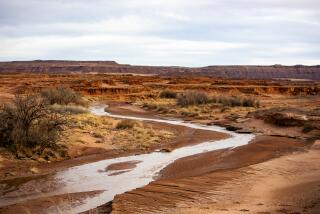Thanksgiving at Dakota Access pipeline protest: ‘It’s a beautiful day to protect the water’

- Share via
Reporting from Along the Cannon Ball River, N.D. — It was still dark on Thanksgiving morning as the pickup truck with mounted speakers rode slowly through the dirt lanes of the Oceti Sakowin camp.
“Wake up, water protectors!” boomed an amplified voice as the truck moved past tents, teepees, and the occasional flickering campfire. “It’s a beautiful day to protect the water.”
Hundreds of opponents of the Dakota Access pipeline were just finishing the morning prayer at the Sacred Fire in the center of the camp. Now they trudged through snow flurries toward the staging area for another day of confronting North Dakota officials over the $3.8-billion pipeline.
“Today we all made sacrifices to be here,” organizer Vic Camp called out through a bullhorn as the group of Native Americans and their supporters began gathering at the southern edge of the camp for a ride north toward Bismarck.
“We left loved ones at home. We left children, mothers, fathers, brothers, sisters, grandchildren at home. We could all be at home, watching football, eating turkey,” Camp said to laughter. “For some reason the Creator brought us here to protect the water. To be the voice for the water. You’re the voice for the sacred river.”
Moments later, a caravan of dozens of SUVs and pickup trucks pulled slowly out of the camp, heading north.
In some ways Thanksgiving Day was just like any other day in the eight-month battle over the 1,172-mile pipeline. The protesters, who prefer to be called “water protectors,” believe the Missouri River could be contaminated if the pipeline is completed and upwards of 570,000 barrels of oil begin to flow.
They have repeatedly clashed with a militarized force of North Dakota police and members of the National Guard, who have regularly deployed pepper spray, rubber bullets and other nonlethal weapons, arresting more than 500 people since August.
Yet this was anything but a typical Thanksgiving for the three Navajo young people riding north in a black Jeep up a sleet-covered state highway.
“I could be spending Thanksgiving with my family up here,” said Armand Begay, who described himself as “half Navajo, half Mexican.” His Lakota uncle operates a buffalo ranch in South Dakota. “But I felt this was more important to me.”
Begay, who grew up in Laguna Beach, said “I spent probably every Thanksgiving before this eating turkey, stuffing, mashed potatoes, pumpkin pie, with my family in a warm home.”
But this year, his attitude has grown more political.
I could be spending Thanksgiving with my family up here. But I felt this was more important to me.
— Armand Begay
Officials in North Dakota “are really, really trying to get that pipeline across the river,” said Begay, riding shotgun and looking at the long line of cars moving north. “And since then they’ve been treading on our land. Since Sitting Bull. Since Wounded Knee. Since Custer died at Little Big Horn.” He said it made him think of what it must have been like to be at the camp 160 years ago. “Being there in the winter,” he said. “It kind of reminds me of being a true Indian.”
On his Facebook page, Begay said, he wrote that this year, “I’m going to Standing Rock. I’ll be with my indigenous family and that’s what I really feel like what I should be doing.”
The two Navajo sisters in the back seat spoke up.
“I did think it was ironic to have another Thanksgiving holiday,” said Crystal Kelly, a 31-year-old air quality specialist for the Southern Ute tribe and mother of three-year-old twins. “Every year, celebrating that holiday, it kind of makes me mad. It’s more like a white holiday, not a Native holiday. And especially hearing about people who are protecting the water, I just couldn’t think about celebrating a Thanksgiving holiday.”
“What are we giving thanks for when we’re being attacked?” asked Kelly’s sister, Megan Dickson, a 21-year-old Navajo mother of three. Dickson’s family was opposed to her coming to Standing Rock, in part because they were concerned for her safety. Leaving was “a little rough,” but “I told them there’s more meaning for me to be out here because there’s no meaning of Thanksgiving when we’re out here fighting for our survival.”
As the SUV pulled into Mandan, a town just across the Missouri River from Bismarck, police vehicles could be seen parked along the roadside, apparently ready to deploy for the coming protest.
Begay, Kelly and Dickson said they didn’t want to be arrested, but were prepared just in case. They scattered into a crowd of perhaps 250, blocking a main intersection of Mandan. The crowd carried signs declaring “Water is Life” and “Don’t Feed the Pilgrim,” and decrying “Genocide Appreciation Day.”
At least two dozen police and sheriff’s vehicles and several long vans, apparently deployed to transport the arrested, stood at the ready. Minutes later, police in riot helmets began lowering their visors and approaching the raucous but peaceful group as observers from Amnesty International and the National Lawyers Guild looked on.
Also watching was L. R. Goethe, 64, of Mandan, whose route was impeded by the demonstration. “It’s time for these people who don’t live here to go home,” he said, as protesters chanted “water is life!”
Asked if Native people might see the day differently, Goethe said, “It isn’t genocide. That’s B.S. You can’t go back 200 years. These people should go home and be with their families and let these law enforcement be with their families.”
A moment later, to the apparent surprise of the protesters, the police cars began to back up and the would-be paddy wagons drove away. The force appeared to be standing down. Police later said they made two arrests.
The rest of the protesters got back in their cars and drove back to Standing Rock. There, later that afternoon, volunteer chefs and celebrity servers, including actresses Jane Fonda and Shailene Woodley, were preparing to serve a Thanksgiving meal to up to 2,000 Standing Rock “water protectors” and local residents.
Outside Standing Rock High School, 210 turkeys were being roasted, 42 at a time above coals on a pedal-powered spit. Inside the high school gymnasium, Standing Rock Warrior team banners and anti-pipeline slogans were affixed to the walls. Fonda greeted families and local fans. “This is historic, what’s happening here,” she said amid a deluge of requests for selfies. “I think it’s important that we show solidarity.”
Fonda has arranged to deliver 20 Mongolian yurts and 2,700 pounds of bison meat from Colorado to the camps. “I think it’s important for people, if they can help, to stand with Standing Rock.”
Then an elder stood up to give a prayer, linking Sitting Bull and Little Big Horn to the contemporary fight at Standing Rock. “Hold up your hand to the stars,” said Jesse Jay Taken Alive, former chairman of the Standing Rock Sioux Tribe. “Let the grandfathers see the palm of our hand. They are going to be with us. They are going to come and protect our water.”
With elders, children and women going first, the people began filing out to receive their Thanksgiving dinner.
Tolan is a special correspondent.
ALSO
Missing Shasta County woman is found safe after three weeks
How is Trump spending Thanksgiving? He says he’s trying save an Indiana factory
UPDATES:
6:07 p.m.: This article was updated with news of a second arrest.
This article was originally published at 3:25 p.m.
More to Read
Sign up for Essential California
The most important California stories and recommendations in your inbox every morning.
You may occasionally receive promotional content from the Los Angeles Times.










